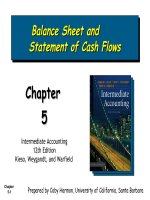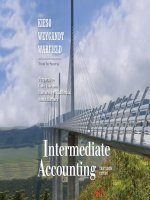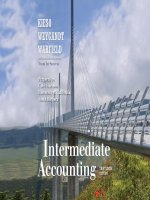Intermediate accounting 15e kieso warfield chapter 05
Bạn đang xem bản rút gọn của tài liệu. Xem và tải ngay bản đầy đủ của tài liệu tại đây (2.99 MB, 98 trang )
INTERMEDIATE
Intermediate
ACCOUNTING
Intermediate
Accounting
Accounting
F I F T E E N T H
5-1
E D I T I O N
Prepared
by
Prepared
by
Coby Harmon
Prepared by
Coby Harmon
Coby Harmon
University
of California
Santa Barbara
University
of California,
Santa Barbara
University of California, Santa Barbara
Westmont
College
Westmont
College
kieso
weygandt
warfield
team for success
PREVIEW OF CHAPTER
5
Intermediate Accounting
15th Edition
Kieso Weygandt Warfield
5-2
5
Balance Sheet and
Statement of Cash Flows
LEARNING OBJECTIVES
After studying this chapter, you should be able to:
1.
2.
5-3
Explain the uses and limitations of a
balance sheet.
Identify the major classifications of the
balance sheet.
3.
Prepare a classified balance sheet using
the report and account formats.
4.
Indicate the purpose of the statement of
cash flows.
5.
Identify the content of the statement of
cash flows
6.
Prepare a basic statement of cash flows.
7.
Understand the usefulness of the
statement of cash flows.
8.
Determine which balance sheet
information requires supplemental
disclosure.
9.
Describe the major disclosure techniques
for the balance sheet.
Balance Sheet
Balance Sheet, sometimes referred to as the statement of
financial position:
1. Reports assets, liabilities, and equity at a specific date.
2. Provides information about resources, obligations to
creditors, and equity in net resources.
3. Helps in predicting amounts, timing, and uncertainty of
future cash flows.
5-4
LO 1 Explain the uses and limitations of a balance sheet.
Balance Sheet
Usefulness of the Balance Sheet
5-5
Computing rates of return.
Evaluating the capital structure.
Assess risk and future cash flows.
Analyze the company’s:
►
Liquidity,
►
Solvency, and
►
Financial flexibility.
LO 1 Explain the uses and limitations of a balance sheet.
GROUNDED
WHAT’S
YOUR PRINCIPLE
The terrorist attacks of September 11, 2001,
showed how vulnerable the major airlines are
to falling demand for their services. Since that
infamous date, major airlines have reduced
capacity and slashed jobs to avoid
bankruptcy. United Airlines, Northwest
Airlines, US Airways, and several smaller
competitors fi led for bankruptcy in the wake
of 9/11. Delta Airlines made the following
statements in its annual report issued shortly
after 9/11:
“If we are unsuccessful in further reducing our
operating costs . . . we will need to restructure
our costs under Chapter 11 of the U.S.
Bankruptcy Code. . . . We have substantial
liquidity needs and there is no assurance that
we will be able to obtain the necessary
financing to meet those needs on acceptable
terms, if at all.”
5-6
These financial flexibility challenges have
continued, exacerbated by ever-increasing
fuel prices, labor costs, and the economic
downturn in response to the financial crisis.
Not surprisingly, several of the major airlines
(Delta and
Northwest, Continental and United, and
Airtran and Southwest) merged recently as a
way to build some competitive synergies and
to bolster their financial flexibility. Others
(American Airlines and US Airways) are
exploring mergers.
Source: R. Seaney, “Airline Mergers: Good for
Travelers?” http://
abcnews.go.com/Travel/airline-merger-maniacost/story?id516227892 (April 27, 2012).
LO 1 Explain the uses and limitations of a balance sheet.
Balance Sheet
Limitations of the Balance Sheet
5-7
Most assets and liabilities are reported at historical
cost.
Use of judgments and estimates.
Many items of financial value
are omitted.
LO 1 Explain the uses and limitations of a balance sheet.
5
Balance Sheet and
Statement of Cash Flows
LEARNING OBJECTIVES
After studying this chapter, you should be able to:
1.
2.
5-8
Explain the uses and limitations of a
balance sheet.
Identify the major classifications of the
balance sheet.
3.
Prepare a classified balance sheet using
the report and account formats.
4.
Indicate the purpose of the statement of
cash flows.
5.
Identify the content of the statement of
cash flows
6.
Prepare a basic statement of cash flows.
7.
Understand the usefulness of the
statement of cash flows.
8.
Determine which balance sheet
information requires supplemental
disclosure.
9.
Describe the major disclosure techniques
for the balance sheet.
Balance Sheet
Classification in the Balance Sheet
5-9
LO 2 Identify the major classifications of the balance sheet.
Balance Sheet
Classification in the Balance Sheet
Illustration 5-1
In practice you usually see little departure from these major subdivisions.
5-10
LO 2 Identify the major classifications of the balance sheet.
Classification in the Balance Sheet
Current Assets
Cash and other assets a company expects to convert into
cash, sell, or consume either in one year or in the
operating cycle, whichever is longer.
Illustration 5-2
5-11
LO 2 Identify the major classifications of the balance sheet.
Classification in the Balance Sheet
Question
The correct order to present current assets is
a. Cash, accounts receivable, prepaid items, inventories.
b. Cash, accounts receivable, inventories, prepaid items.
c. Cash, inventories, accounts receivable, prepaid items.
d. Cash, inventories, prepaid items, accounts receivable.
Order of Liquidity
5-12
LO 2 Identify the major classifications of the balance sheet.
Balance Sheet – “Current Assets”
Cash
Generally any monies available “on demand.”
Cash equivalents - short-term highly liquid investments
that mature within three months or less.
Restrictions or commitments must be disclosed.
Illustration 5-3
Balance Sheet—Restricted Cash
5-13
LO 2
Balance Sheet – “Current Assets”
Cash
Illustration 5-4
Balance Sheet—Restricted Cash
5-14
LO 2 Identify the major classifications of the balance sheet.
Balance Sheet – “Current Assets”
Short-Term Investments
5-15
Portfolios
Type
Valuation
Classification
Held-toMaturity
Debt
Amortized
Cost
Current or
Noncurrent
Trading
Debt or
Equity
Fair Value
Current
Availablefor-Sale
Debt or
Equity
Fair Value
Current or
Noncurrent
LO 2 Identify the major classifications of the balance sheet.
Balance Sheet – “Current Assets”
Short-Term Investments
Illustration 5-5
Balance Sheet Presentation of
Investments in Securities
5-16
LO 2 Identify the major classifications of the balance sheet.
Balance Sheet – “Current Assets”
Receivables
Major categories of receivables should be shown in the
balance sheet or the related notes.
A company should clearly identify
5-17
Anticipated loss due to uncollectibles.
Amount and nature of any nontrade receivables.
Receivables used as collateral.
LO 2 Identify the major classifications of the balance sheet.
Balance Sheet – “Current Assets”
Receivables
Illustration 5-6
Balance Sheet Presentation
of Receivables
5-18
LO 2
Balance Sheet – “Current Assets”
Inventories
Disclose:
►
Basis of valuation (e.g., lower-of-cost-or-market).
►
Cost flow assumption (e.g., FIFO or LIFO).
Illustration 5-7
Balance Sheet Presentation of Inventories
5-19
LO 2
Balance Sheet – “Current Assets”
Prepaid Expenses
Payment of cash, that is recorded as an asset because
service or benefit will be received in the future.
Cash Payment
Expense Recorded
BEFORE
Prepayments often occur in regard to:
5-20
insurance
rent
supplies
taxes
advertising
LO 2 Identify the major classifications of the balance sheet.
Balance Sheet – “Current Assets”
Prepaid Expenses
Illustration 5-9
Balance Sheet Presentation
of Prepaid Expenses
5-21
LO 2 Identify the major classifications of the balance sheet.
Balance Sheet – “Current Assets”
Summary
Cash and other assets
a company expects to
convert into cash,
sell, or
consume
either in one year or in
the operating cycle,
whichever is longer.
5-22
LO 2 Identify the major classifications of the balance sheet.
Classification in the Balance Sheet
Noncurrent Assets
Long-term Investments
5-23
1.
Securities (bonds, common stock, or long-term notes).
2.
Tangible fixed assets not currently used in operations
(land held for speculation).
3.
Special funds (sinking fund, pension fund, plant expansion
fund, or cash surrender value of life insurance).
4.
Nonconsolidated subsidiaries or affiliated companies.
LO 2 Identify the major classifications of the balance sheet.
Balance Sheet – “Noncurrent Assets”
Long-Term Investments
5-24
Portfolios
Type
Valuation
Classification
Held-toMaturity
Debt
Amortized
Cost
Current or
Noncurrent
Trading
Debt or
Equity
Fair Value
Current
Availablefor-Sale
Debt or
Equity
Fair Value
Current or
Noncurrent
LO 2 Identify the major classifications of the balance sheet.
Balance Sheet – “Noncurrent Assets”
Long-Term
Investments
Securities
Securities
Bonds,
Stock, and
Long-term notes
For marketable securities,
management’s intent
determines current or
noncurrent classification.
5-25
LO 2









